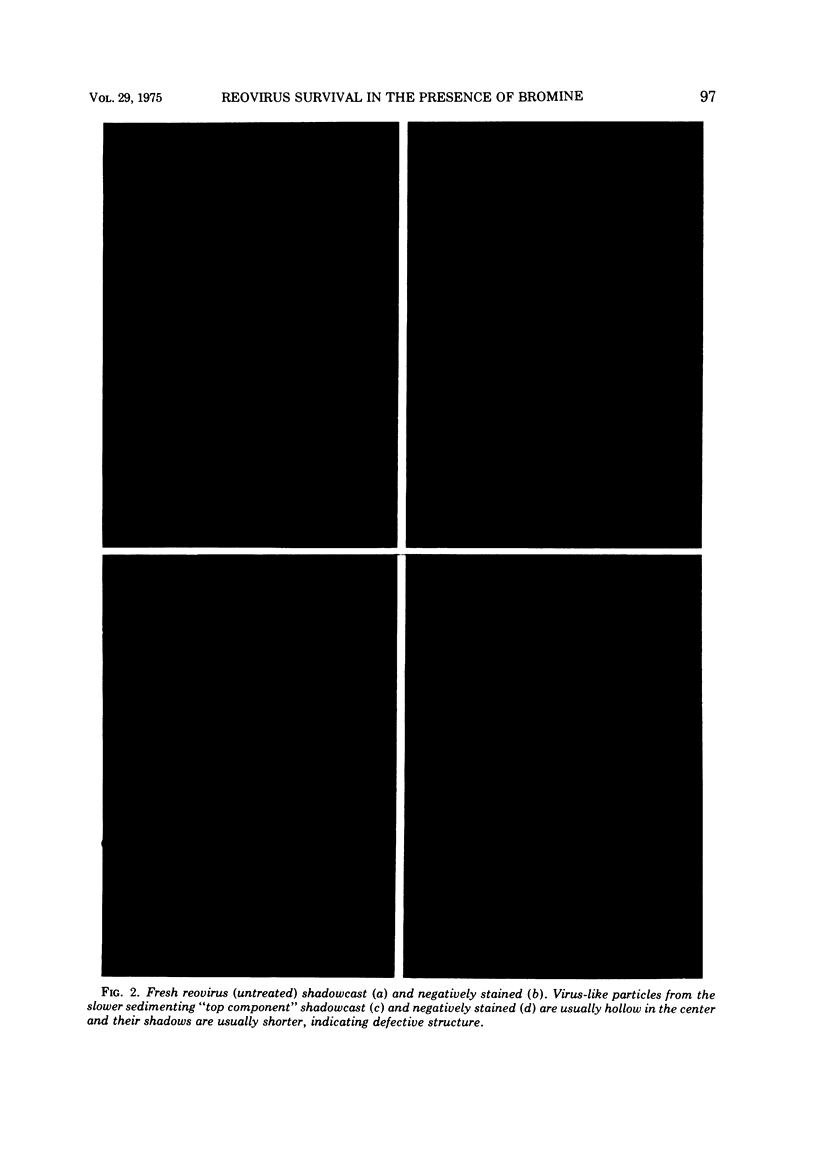Abstract
The initial inactivation of reovirus in water containing 3 to 7 μM bromine as HOBr was very rapid. Electron microscopy revealed extensive physical damage to the virions in as little as 1 min, but none were degraded beyond recognition. As treatment time continued, the reaction rate decreased toward a plateau of resistance, usually at about the 10-4 survival level; still no particles were lost. Progeny grown from these resistant plaque-forming units (PFU) were no more resistant to HOBr than the parent cultures. Small-number aggregation (adhering groups of two to ten virions counted by electron microscopy) had no detectable effect on the level of persistant PFU. Large aggregates seemed to be involved. Sonic treatment at 20 kHz after bromine exposure increased survival PFU titer 10- to 43-fold. Virus exposed to light centrifugation prior to bromine treatment did not show the plateau of resistance. Surviving PFU sedimented faster in a shallow sucrose gradient than single virions. Large aggregates were apparently too few to be counted by electron microscopy, but their penetration and inactivation must be achieved by any disinfectant chosen to rid water of reovirus.
Full text
PDF







Images in this article
Selected References
These references are in PubMed. This may not be the complete list of references from this article.
- ABEL P. Multiplicity reactivation and marker rescue with vaccinia virus. Virology. 1962 Aug;17:511–519. doi: 10.1016/0042-6822(62)90150-2. [DOI] [PubMed] [Google Scholar]
- BERG G., CHANG S. L., HARRIS E. K. DEVITALIZATION OF MICROORGANISMS BY IODINE. I. DYNAMICS OF THE DEVITALIZATION OF ENTEROVIRUSES BY ELEMENTAL IODINE. Virology. 1964 Apr;22:461–481. doi: 10.1016/0042-6822(64)90068-6. [DOI] [PubMed] [Google Scholar]
- Brown J. R., McLean D. M. Observations on halogens as bathing water disinfectants. J Appl Bacteriol. 1966 Dec;29(3):559–565. doi: 10.1111/j.1365-2672.1966.tb03509.x. [DOI] [PubMed] [Google Scholar]
- SALK J. E., GORI J. B. A review of theoretical, experimental, and practical considerations in the use of formaldehyde for the inactivation of poliovirus. Ann N Y Acad Sci. 1960 Jan 13;83:609–637. doi: 10.1111/j.1749-6632.1960.tb40933.x. [DOI] [PubMed] [Google Scholar]
- Sharp D. G. Multiplicity reactivation of animal viruses. Prog Med Virol. 1968;10:64–109. [PubMed] [Google Scholar]
- Smith R. E., Zweerink H. J., Joklik W. K. Polypeptide components of virions, top component and cores of reovirus type 3. Virology. 1969 Dec;39(4):791–810. doi: 10.1016/0042-6822(69)90017-8. [DOI] [PubMed] [Google Scholar]
- VALENTINE R. C., ALLISON A. C. Virus particle adsorption. I. Theory of adsorption and experiments on the attachment of particles to non-biological surfaces. Biochim Biophys Acta. 1959 Jul;34:10–23. doi: 10.1016/0006-3002(59)90228-8. [DOI] [PubMed] [Google Scholar]




